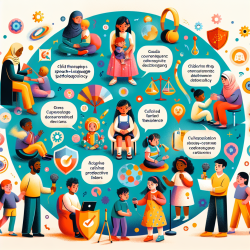Understanding Resilience in Challenging Contexts
Resilience, a concept often explored in various disciplines, refers to the ability to recover from or adapt to difficult situations. The research article "Measuring Resilience in the Context of Conflict-Related Sexual Violence: A Novel Application of the Adult Resilience Measure (ARM)" provides new insights into resilience, particularly in the context of conflict-related sexual violence in Bosnia-Herzegovina, Colombia, and Uganda. This study, which is the first to apply the Adult Resilience Measure (ARM) in such contexts, offers valuable lessons that can be translated into practice for child therapy, especially in challenging environments.
The Importance of Cultural Contexts in Resilience
The research highlights that resilience is not a one-size-fits-all construct. Different cultural contexts and social ecologies significantly influence how resilience is manifested and measured. For practitioners in speech language pathology and child therapy, understanding these nuances is crucial. It suggests that therapy approaches should be tailored to the specific cultural and social contexts of the children being served. This can lead to more effective interventions that leverage the existing protective resources in a child's environment.
Key Findings and Their Implications
The study found that the factor structures of resilience varied across the three countries, underscoring the importance of considering local contexts in resilience-building efforts. For instance, in Bosnia-Herzegovina, social and community relations were significant protective resources, while in Uganda, familial bonds and community cooperation were more prominent. These findings suggest that practitioners should focus on strengthening the specific protective factors that are most relevant in the child's cultural context.
- Social and Community Relations: Encourage community involvement and support networks as they can provide a sense of safety and belonging.
- Familial Bonds: Strengthen family support systems, as they are crucial in providing emotional and practical support to children.
- Individual Strengths: Recognize and build on the child's individual strengths and capabilities, promoting self-efficacy and confidence.
Practical Applications for Child Therapy
For practitioners working with children, particularly in online therapy settings like those provided by TinyEYE, these insights can be instrumental. By focusing on enhancing the protective factors identified in the research, therapists can create more resilient outcomes for children. This might involve integrating community resources into therapy plans, engaging family members in the therapeutic process, and adapting therapy techniques to align with the child's cultural background.
Encouraging Further Research
While this study provides a foundation, there is a need for further research to explore resilience in different contexts and among different populations. Practitioners are encouraged to contribute to this growing body of knowledge by conducting studies within their own practice settings. This can help refine therapeutic approaches and ensure they are grounded in robust, evidence-based practices.
To read the original research paper, please follow this link: Measuring Resilience in the Context of Conflict-Related Sexual Violence: A Novel Application of the Adult Resilience Measure (ARM)










